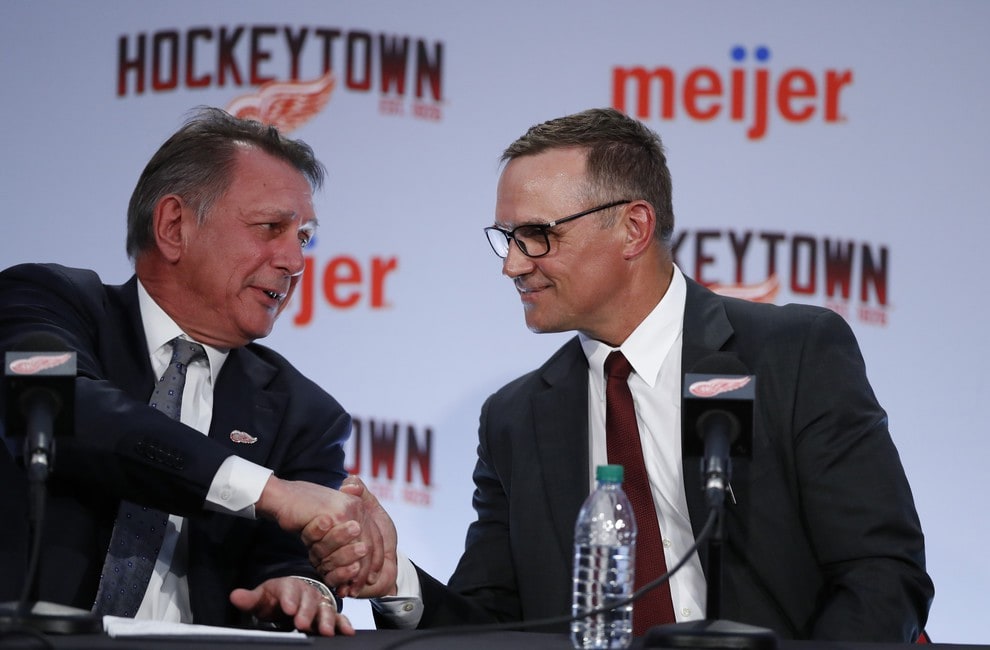In the public sphere, the Detroit Red Wings’ rebuilding strategy under Steve Yzerman is commonly referred to as the Yzerplan. Trust and belief in it is a sign of patriotism among Red Wings fans. Questioning it, though, is akin to challenging anti-communist sentiment in post-war America – downright traitorous.
But what exactly is the Yzerplan?

Sure, “draft and develop” is the party line. But then how do you explain the flurry of free agent signings—a collection of mid-level players—this summer and last? Aren’t those players taking up roster spots that could go to prospects?
To answer these questions, I did a deep dive into the Yzerplan. This is my attempt to dissect Detroit’s rebuilding strategy in order to better understand it, measure how the organization is progressing, and what’s next for the Red Wings.
Yzerman’s Rebuilding Strategy
If you break it down, rebuilds have four stages:
- Tear it down
- Accumulate high-end picks at rock bottom
- Build back up
- Contend
Some rebuilds are short – aided by the acquisition of a generational talent or two. Others take longer. Timelines are influenced by luck, but also the savviness of the team’s front office.
Detroit’s pace—which rivals that of I-96 in the summer—is intentional. Slow and steady – not to be rushed. This is done to maximize player growth in the system, leading to a better on-ice product down the road.

Yzerman’s methodical approach—the Yzerplan—within the framework of a rebuild can be broken down into five steps:
- Draft – Find, target, and select high-end, high-character prospects.
- Develop – Provide adequate time (and resources) for prospects to grow in junior, European, or minor leagues.
- Compete – Create meaningful competition in order for these prospects to earn professional roles.
- Mature – Once in Detroit, surround the prospects with strong leaders so they can learn to play the right way.
- Lead – Demand that these players step up and take charge of the team.
Success—on an individual level—is only achieved when a player meets (or exceeds) expectations on the final step. In essence, the velocity of Detroit’s rebuild equals the velocity of players advancing through these five steps, which brings us to…
Latest News & Highlight
Current State of the Red Wings’ Rebuild
Now that we know what Detroit’s rebuilding strategy is, we can properly assess its progress.
To this point, only Dylan Larkin, Moritz Seider, Lucas Raymond, and Michael Rasmussen have reached the fifth step noted above. It’s fair to add Alex DeBrincat to this group, too. This is more or less Detroit’s current core.
Joe Veleno and Jonatan Berggren are currently on Step 4. Neither are top-of-the-lineup players – Veleno is a strong fourth-line center and Berggren projects to be an above-average bottom-six wing.

Behind them are a slew of prospects progressing through the ranks. Simon Edvinsson, Marco Kasper, Elmer Soderblom, and Carter Mazur are the closest to graduating to the fourth step. They’re expected to challenge for NHL roster spots this fall, and have a steep hill to climb with the competition Yzerman brought in this summer.
Through this lens, the Red Wings have a long way to go. But at the very least, they have significant pieces already in place – Larkin as their 1C and Seider as a top-pairing defenseman.
Another litmus test is to look at the roster five years down the road and attempt to poke holes in it.
Is this team competitive? Are there any gaps? How much risk are you assuming with certain players and roles?
With those questions in mind, here is a projection for Detroit’s 2028-29 roster, with each player’s age noted in parenthesis.
| LW | C | RW |
| Alex DeBrincat (30) | Dylan Larkin (32) | Lucas Raymond (26) |
| Marco Kasper (24) | Nate Danielson (23) | Carter Mazur (26) |
| Jonatan Berggren (28) | Michael Rasmussen (29) | Dmitri Buchelnikov (25) |
| Elmer Soderblom (27) | Joe Veleno (28) | Amadeus Lombardi (25) |
| Cross Hanas (26) |
| LD | RD | G |
| Simon Edvinsson (25) | Moritz Seider (27) | Sebastian Cossa (25) |
| William Wallinder (26) | Axel Sandin Pellikka (23) | Trey Augustine (23) |
| Brady Cleveland (23) | Albert Johansson (27) | |
| Shai Buium (25) | Andrew Gibson (23) |
A few items immediately pop out:
- The defense and goaltending look superb
- The offense, though, needs more firepower – even with DeBrincat
- While the centers slot in well, most of the wings need to be bumped down a line
Generally speaking, the top-six forwards, top-four defensemen, and starting goalies are really the only ones that matter in this exercise – the other roles can be filled in by free agents, waiver pickups, and minor trades.
Still, there’s still work to be done. I’d feel more comfortable projecting a 30-year-old—and turning 31 midway through the season—DeBrincat as a second-line player. The same goes for Raymond.
What’s Next for the Red Wings?
Moving forward, Yzerman and the Red Wings have two main priorities: Add more top-line scoring and to continually improve the infrastructure associated with the five player development steps.
If completed, these action items will propel the Red Wings back into contention. They’re tall tasks—no doubt—but definitely possible.
Yzerman’s strategy—the Yzerplan—is working. Slowly, but surely. As intended. But it’s far from over – even with DeBrincat now in the fold.
